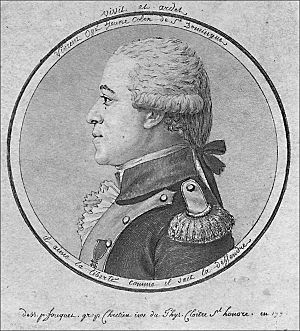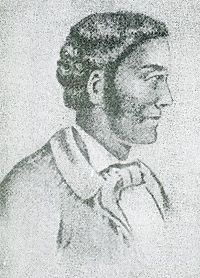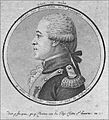Vincent Ogé facts for kids
Quick facts for kids
Vincent Ogé
|
|
|---|---|
 |
|
| Born | c. 1757 Dondon, Saint-Domingue
|
| Died | February 6, 1791 (aged 33–34) Cap‑Français, Saint-Domingue
|
| Occupation | Merchant, military officer and goldsmith |
| Known for | Leading a failed uprising against French colonial rule |
| Parent(s) | Jacques Ogé Angélique Ossé |
Vincent Ogé (born around 1757 – died February 6, 1791) was a revolutionary leader from Saint-Domingue. This was a French colony that is now the country of Haiti. Ogé was a merchant, a military officer, and a goldsmith. He is most known for leading an uprising against French rule in 1790.
Ogé was a person of mixed race from a wealthy family in the colony. His revolt happened just before the big Haitian Revolution. That revolution led to Haiti becoming independent from France.
Vincent Ogé was born in Saint-Domingue into a family that owned enslaved people. When he was about eleven, his parents sent him to Bordeaux, France. There, he learned to be a goldsmith. After seven years, he returned to the colony. He settled in Cap‑Français and worked as a coffee merchant for his uncle. He also gained part ownership of his family's plantation. By the 1780s, Ogé's business made him the richest merchant of African descent in the city.
In 1788, Ogé traveled to France to deal with his debts and family lawsuits. A year later, the French Revolution began, and he joined the revolutionaries. He tried to get laws changed to give free people of color equal rights. When white plantation owners refused, he joined a group that wanted political representation in the French national assembly.
In March 1790, the assembly passed a law giving voting rights to free people of color in French colonies. Ogé returned to Saint-Domingue that same month. He rebelled against the colonial government when it refused to follow the new law. His uprising was stopped, and Ogé was captured and executed. After his death, his story was used in different ways, which changed how people viewed him over time.
Contents
Early Life and Business
Vincent Ogé was born around 1757 in Dondon, Saint-Domingue. At that time, Saint-Domingue was the western part of the island of Hispaniola. It was under French rule as part of France's colonies in the French West Indies. Ogé's father was Jacques Ogé, a white Frenchman. His mother was Angélique Ossé, a free woman of color. He had several brothers and sisters.
The Ogé family owned a coffee plantation. Many enslaved laborers worked there, which was the main source of the family's wealth. His mother also had a contract to supply meat to the markets in Dondon.
Becoming a Goldsmith and Merchant
In 1768, when he was eleven, Ogé was sent to Bordeaux in France. He trained as a goldsmith for about seven years. In 1775, he returned to Saint-Domingue. Instead of going back to Dondon, Ogé settled in the colonial capital, Cap‑Français. He worked for his uncle Vincent as an agent in the colony's coffee trade. During this time, Ogé gained partial ownership of his family's plantation. In the 1780s, Ogé also became part owner of a merchant schooner. This ship operated out of the colony with three of his business partners.
Ogé quickly grew his business. He made deals with merchants in many of Saint-Domingue's main ports. He also worked as a real estate agent in Cap‑Français. He rented out valuable properties to the wealthy people of the colony. Because of his business dealings, Ogé became the richest businessman of African descent in Cap‑Français during the 1780s. However, by 1788, Ogé was deeply in debt. He owed a lot of money to people he borrowed from. He decided to move to Port-au-Prince with some goods and enslaved people.
Ogé's Fight for Rights
After moving to Port-au-Prince, Ogé continued working as a merchant. He sold his goods and helped a ship's captain sell his cargo. He still had debts, but after six months, he had earned a lot of money. Around this time, Ogé planned to travel to France. He wanted to buy goods to resell in Saint-Domingue and pay off his debts. His family also had lawsuits about their enslaved people being injured during construction in Dondon. Ogé hoped to bring these cases to the King's Council in France.
Joining the French Revolution
In 1788, he traveled to France for the second time. A year later, the French Revolution began. Ogé, who was in Paris at the time, supported the revolutionaries. In August 1789, he met with a group of plantation owners. He wanted to discuss ending unfair laws against free people of color in Saint-Domingue. The plantation owners refused his ideas. This led Ogé to join a group of free people of color. This group was led by a white lawyer named Étienne de Joly. Its members demanded that people of mixed race from the colonies get a voice in the National Constituent Assembly.
By October 1789, Ogé had joined the Paris militia as an officer. Around the same time, he joined the Society of the Friends of the Blacks. This group worked to end slavery. Along with Julien Raimond, Ogé quickly became a leader of de Joly's group. They became the public voice for the political concerns of free people of color in France. Ogé and Raimond argued to the National Constituent Assembly. They pushed for Black representation and full voting rights for free people of color in Saint-Domingue. Both men owned enslaved people, and they supported slavery continuing in the colonies.
The Law and His Return
In March 1790, the National Constituent Assembly passed a law. It was written in a way that was not very clear. But it seemed to grant full voting rights to free people of color in French colonies. After the law passed, Ogé secretly returned to Saint-Domingue. He wanted to avoid drawing attention from hostile plantation owners. During his trip, he stopped in London. He met with abolitionists in Britain, including Thomas Clarkson. Clarkson supported Ogé's arguments for the rights of free people of color. After this meeting, Ogé landed in Saint-Domingue after stopping in Charleston, South Carolina.
In October 1790, the same month he arrived, Ogé met with Jean-Baptiste Chavannes. Chavannes was a non-commissioned officer in the colonial militia. Together, they sent a letter to Governor Philibert François Rouxel de Blanchelande and the colony's assembly. They demanded that the colonial government give free people of color the full rights promised in the March 1790 law. However, both the governor and the assembly refused. This led Ogé and Chavannes to plan to overthrow the colonial government by force. They gathered about 300 free men of color 12 miles outside Cap‑Français.
The Uprising and Its End
In late October, the colonial government heard about Ogé and Chavannes' actions. They sent about 600 militia members, led by a general named de Vincent, to stop the rebels. However, the rebels fought well and pushed back the government force. The government troops had to retreat to Cap‑Français. Many of the rebels had served in the colonial militia. They organized themselves into battalions, chose their own officers, and strengthened their positions.
Because the first attack failed, a leader named Colonel Cambefort was sent from Cap‑Français. He had 1,500 men. Many of these were soldiers from the French Royal Army. Cambefort's troops defeated Ogé and Chavannes' rebels. A large number of the rebels had already left. Ogé and Chavannes managed to escape the colonial government. They fled to the nearby Captaincy General of Santo Domingo, which was a Spanish colony.
Capture and Execution
On November 20, 1790, Ogé and 23 rebels, including Chavannes, were captured. This happened in the town of Hinche. They surrendered after the Spanish promised them safety. However, the Spanish colonial authorities handed Ogé and his friends over to the French. The rebels were marched to Cap‑Français under armed guard and put in prison. In January 1791, the French prosecutor Bocquet de Frévent questioned Ogé.
In February 1791, Ogé was put on trial by the colonial government in Cap‑Français. He was sentenced to death. Ogé was executed on February 6. Governor Blanchelande and several politicians from the colonial assembly were present.
Six months after Ogé's execution, enslaved people led by Dutty Boukman started a revolt. This began the Haitian Revolution. Ogé never fought against slavery itself. But his execution was often mentioned by the rebel enslaved people during the revolution. They used it as a reason to keep fighting the French colonial government. After twelve years of fighting, the rebels successfully ended French rule in Saint-Domingue.
Ogé's Legacy
Historian John D. Garrigus noted that "Ogé's identity, even his name, has been the subject of some confusion." After his death, historians made different claims about Ogé's background and actions. But they often pointed out that it was unusual for someone from the wealthy, mostly traditional, mixed-race class to try to overthrow French rule by force. Garrigus also mentioned that Ogé's 1791 interview suggested his last name might have been spelled with "Au" instead of "O," like Augé or Auger.
Family Life
Ogé was born into a large family. He had seven brothers and sisters, plus an unknown number who died young. He had three brothers: Joseph, Jacques, Jean-Pierre, and Alexandre (who was adopted). Ogé also had three sisters: Françoise, Angélique, and a third sister whose name is unknown. Before 1788, Françoise and Angélique had moved to Bordeaux. Ogé never married. He had a housekeeper named Marie Magdeleine Garette from 1781 to 1783. He paid her by giving her a young enslaved girl.
How History Remembers Him
Views of Ogé in history, both in and outside Haiti, have changed a lot. In 1914, an American scientist named Lothrop Stoddard wrote that Ogé was "convinced that he was destined to lead a successful rising of his caste." Twenty-four years later, Trinidadian historian C. L. R. James wrote that Ogé was a member of the French middle class "whose gifts were unsuited to the task before him." In 1988, British historian Robin Blackburn said Ogé was connected to the Freemasons in France.
Among African Americans, Ogé was remembered positively before the American Civil War. In 1853, the poet and abolitionist George Boyer Vashon wrote a long poem called Vincent Ogé. It included lines like "Thy coming fame, Ogé! Is sure; Thy name with that of L'Ouverture". A similar positive view of Ogé was common in Haiti during the 1800s. His story was used to promote the power of Haiti's mixed-race elite. This led to Ogé's reputation in Haiti falling apart by the 1900s. In Haitian history, he was then described as a "flawed and minor revolutionary figure."
Images for kids




